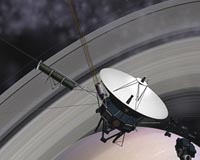 |
Pasadena CA (JPL) Dec 30, 2009 The solar system is passing through an interstellar cloud that physics says should not exist. In the Dec. 24th issue of Nature, a team of scientists reveal how NASA's Voyager spacecraft have solved the mystery. "Using data from Voyager, we have discovered a strong magnetic field just outside the solar system," explains lead author Merav Opher, a NASA Heliophysics Guest Investigator from George Mason University. "This magnetic field holds the interstellar cloud together and solves the long-standing puzzle of how it can exist at all." The discovery has implications for the future when the solar system will eventually bump into other, similar clouds in our arm of the Milky Way galaxy. Astronomers call the cloud we're running into now the Local Interstellar Cloud or "Local Fluff" for short. It's about 30 light years wide and contains a wispy mixture of hydrogen and helium atoms at a temperature of 6000 C. The existential mystery of the Fluff has to do with its surroundings. About 10 million years ago, a cluster of supernovas exploded nearby, creating a giant bubble of million-degree gas. The Fluff is completely surrounded by this high-pressure supernova exhaust and should be crushed or dispersed by it. "The observed temperature and density of the local cloud do not provide enough pressure to resist the 'crushing action' of the hot gas around it," says Opher. So how does the Fluff survive? The Voyagers have found an answer. "Voyager data show that the Fluff is much more strongly magnetized than anyone had previously suspected-between 4 and 5 microgauss*," says Opher. "This magnetic field can provide the extra pressure required to resist destruction." NASA's two Voyager probes have been racing out of the solar system for more than 30 years. They are now beyond the orbit of Pluto and on the verge of entering interstellar space-but they are not there yet. "The Voyagers are not actually inside the Local Fluff," says Opher. "But they are getting close and can sense what the cloud is like as they approach it." The Fluff is held at bay just beyond the edge of the solar system by the sun's magnetic field, which is inflated by solar wind into a magnetic bubble more than 10 billion km wide. Called the "heliosphere," this bubble acts as a shield that helps protect the inner solar system from galactic cosmic rays and interstellar clouds. The two Voyagers are located in the outermost layer of the heliosphere, or "heliosheath," where the solar wind is slowed by the pressure of interstellar gas. Voyager 1 entered the heliosheath in Dec. 2004; Voyager 2 followed almost 3 years later in Aug. 2007. These crossings were key to Opher et al's discovery. The size of the heliosphere is determined by a balance of forces: Solar wind inflates the bubble from the inside while the Local Fluff compresses it from the outside. Voyager's crossings into the heliosheath revealed the approximate size of the heliosphere and, thus, how much pressure the Local Fluff exerts. A portion of that pressure is magnetic and corresponds to the ~5 microgauss Opher's team has reported in Nature. The fact that the Fluff is strongly magnetized means that other clouds in the galactic neighborhood could be, too. Eventually, the solar system will run into some of them, and their strong magnetic fields could compress the heliosphere even more than it is compressed now. Additional compression could allow more cosmic rays to reach the inner solar system, possibly affecting terrestrial climate and the ability of astronauts to travel safely through space. On the other hand, astronauts wouldn't have to travel so far because interstellar space would be closer than ever. These events would play out on time scales of tens to hundreds of thousands of years, which is how long it takes for the solar system to move from one cloud to the next. "There could be interesting times ahead!" says Opher. To read the original research, look in the Dec. 24, 2009, issue of Nature for Opher et al's article, "A strong, highly-tilted interstellar magnetic field near the Solar System."
Share This Article With Planet Earth
Related Links Voyager at JPL Space Tourism, Space Transport and Space Exploration News
 Fantastic Voyage
Fantastic VoyageMoffett Field CA (SPX) Nov 03, 2009 Twenty years ago, Voyager 2 left Neptune behind. The robotic spacecraft had taken advantage of a rare alignment of the outer planets that enabled it to visit Jupiter, Saturn, Uranus and Neptune in a single shot. Voyager 2 had launched before its sister ship, Voyager 1, on August 24, 1977. Voyager 1 lifted off just a few days later, on September 5, 1977, on a faster trajectory headed for ... read more |
|
| The content herein, unless otherwise known to be public domain, are Copyright 1995-2009 - SpaceDaily. AFP and UPI Wire Stories are copyright Agence France-Presse and United Press International. ESA Portal Reports are copyright European Space Agency. All NASA sourced material is public domain. Additional copyrights may apply in whole or part to other bona fide parties. Advertising does not imply endorsement,agreement or approval of any opinions, statements or information provided by SpaceDaily on any Web page published or hosted by SpaceDaily. Privacy Statement |